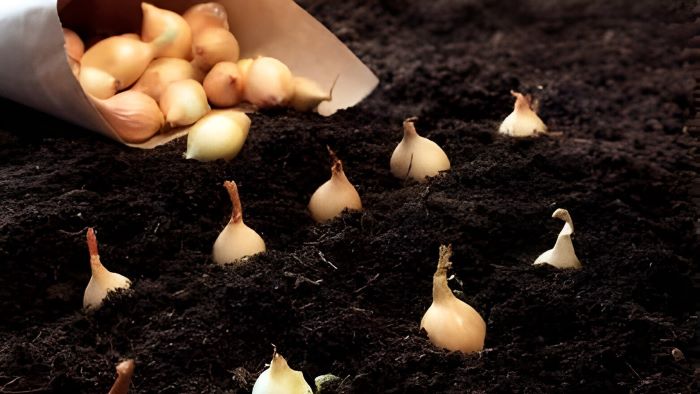Onions are one of the delicious vegetables you can grow in your home garden. We all know, they add flavor and crunch to salads, soups, stir-fries, and more. So, ready to add some flavor to your garden? Yes? Well, look no further! In this step-by-step guide, we’ll show you how to plant onion bulbs like a pro.
Bulbs are the dormant, underground parts of onion plants that store energy and nutrients for the next growing season. By planting onion bulbs, you can get a head start on your harvest. And enjoy fresh onions earlier than usual. Plus, you can choose from a variety of onion types, such as red, white, yellow, or sweet. Moreover, we will also show you how to prepare the soil, select the right bulbs, and care for them until they are ready to harvest.
So, sit back and follow along!🧅🌱
Contents
When to Plant Onion Bulbs?
The best time to plant onion bulbs depends on the type of onion and the climate you live in. Onions are categorized into three types based on the day length they need to form bulbs: short-day, long-day, and intermediate-day onions. Such as; short-day onions need 10–12 hours of daylight, long-day onions need 14–16 hours, and intermediate-day onions need 12–14 hours.

Furthermore, you can plant onion bulbs in early spring as soon as the ground can be worked. Or in autumn, about a month before the first frost. We recommend you plant the bulbs when you get them, and store them in a cool/dry location for up to two weeks.
Steps for Planting Onion Bulbs!
Onion bulbs are small, dried onions that are easy to grow. These onion bulbs are known as sets, and, are easy to produce mature onions in a shorter time, as compared to seeds. They are available in different colors and types, depending on your preference and climate. If you wish to plant onion bulbs, you need to follow the basic steps:
1. Choose the Right Type and Time of Onion to Plant
Onions come in three general colors; white, yellow, and red/purple, each with their distinct taste. Additionally, onions are categorized into two growing types: long-day and short-day.

For instance, long-day onions are named such because they begin sprouting when the days are between 14 and 16 hours in length. Plus, they grow the best in northern states. While on the other hand, short-day, onions begin sprouting when days are between 10 and 12 hours in length, and they grow the best in southern states.
Choose the onion variety that suits your climate and the current season.
2. Prepare the Planting Site and Soil
Now, it’s time to set the planting site. Onions need lots of sun and perform best in fertile soil on the sandy side with a pH of 6.0 to 7.0. If your soil is heavy with clay, then planting in a raised bed is a good option. Otherwise, you can fertilize the soil with a well-aged compost or a commercial organic planting mix before planting.
Furthermore, you can grow onions in pots as well. But, make sure to use plastic pots with plenty of drainage holes and add organic compost to the potting mix for better results.
3. Plant the Onion Sets
So far, we learned onion sets are small, dried onions grown and harvested as immature bulbs. They are easier to grow than onion seeds and stand up to poor weather better. We recommend you plant the onion sets as soon as you get them. For that, you need to dig a hole in the ground that’s about 2 inches deep. Plant the sets in the hole with the root end facing down and the tip facing upwards. Then cover the tips of the sets with an inch of soil, but not more.

Remember, if you plant too deeply, it will affect bulb development. It’s important to space the onion sets five to six inches apart..
4. Fertilize and Harvest the Onions
It’s true, that onions benefit from a high-nitrogen fertilizer to encourage leaf growth and bulb development. You can apply a 10-10-10 fertilizer every few weeks until the bulbs form. Plus, you can also use bone meal and blood meal as organic alternatives.
It is recommended to stop fertilizing once the bulbing begins, as this can reduce the storage quality of the onions. In addition, you can harvest the onions when the tops begin to yellow and fall over. This usually occurs in late summer or early fall.
All these tips will help you grow healthy and tasty onions. Happy gardening! 🌱
Read More:
- Basic gardening tips
- How to germinate lemon seeds in paper towel?
- How to plant watermelon seeds in the ground?
How Far Apart to Plant Onion Bulbs?
We know onion bulbs are small, dried onions that are used to grow new onion plants. Plus, they come in different types and colors, such as white, yellow, and red. But, when it comes to the spacing of onion bulbs, it solely depends on how you want to harvest them and the planting technique you use. For your reference, we have covered some general guidelines for how far apart to plant onion bulbs:
For example, if you want to harvest green onion bulbs, you need to plant them closer together, about 2 inches apart. You can also plant them in containers, making holes 1 inch deep and 3 inches apart. But if you are harvesting small to medium-sized onion bulbs, then you should plant the bulbs 3 to 4 inches apart. You can also plant them in rows, spacing the rows at least 8 inches apart.

When harvesting large bulbs for storage, you should plant them 4 to 6 inches apart. You can also plant them in a grid pattern, or space the rows 12 to 18 inches apart.
How to Grow Onions From Seeds?
So far, we learned how to plant onion bulbs easily. Is it possible to grow onions from seeds? Yes, folks, you can easily grow onions from seeds as well. There are three categories of onions: short-day, long-day, and day-neutral. These categories are based on your plant’s hardiness and the growing zone you reside in. It is necessary, to choose the right type of onion for your region and climate.
For your better knowledge, we have jotted down the main steps to grow onions from seeds:
- Start the onion seeds indoors, 8 to 10 weeks before the last frost date. This will give the seedlings a head start and allow them to germinate into healthy seedlings before you transplant them outside.
- Take a shallow container about 4 inches deep, with a good drainage hole. Then fill it with a dampened seed starting mix.

- Plant the seeds according to the label on your seed packet. But, if you don’t have the seed packet anymore, you can begin by sprinkling the seeds over the damp soil. Then mist them lightly with water, and cover them with a 1/8 inch thick layer of seed mix. Followed by gently patting the soil with your hand when you are done.
- After planting the seeds, cover them with a humidity dome, and keep them in a warmer place. If it is too cold where you live, place the containers on a heat mat. Expect to see the seedlings emerge after 7 to 10 days.
- Lastly, start hardening the seeds 4 weeks before the last frost date.
FAQs
Where to buy onion bulbs?
You can buy onion bulbs from local nurseries, garden centers, or online stores. But, make sure to choose the right type of onion for your region and climate. There are short-day, long-day, and intermediate-day onions that differ in their day length requirements for bulb formation.
How deep do you plant onion bulbs?
Onion bulbs, also known as sets, it should be planted with the pointed end facing up, at a depth of approximately 1 inch into the soil. Planting onion bulbs too shallow or too deep can affect the growth and yield of the onion. So, it is recommended to space the onion bulbs 4–6 inches apart.
Do you soak onion bulbs before planting?
Soaking onion bulbs before planting is not necessary, but some gardeners prefer to do so to speed up germination and root development. You can soak the onion bulbs in lukewarm water for about an hour before planting. However, be careful not to damage the bulbs or expose them to fungal diseases during soaking.

Hello, I’m Rose Lehman, the content writer of cozynest. I have been a gardener for over 5 years, and I have a certificate in master gardening from the Oregon State University Extension Service. I enjoy writing about all aspects of gardening, from the basics to the advanced, and from the practical to the creative. I also love to explore different types of gardens, cultures, and styles, and share them with our readers. My goal is to inspire and inform our audience, and help them grow their own cozynest.

